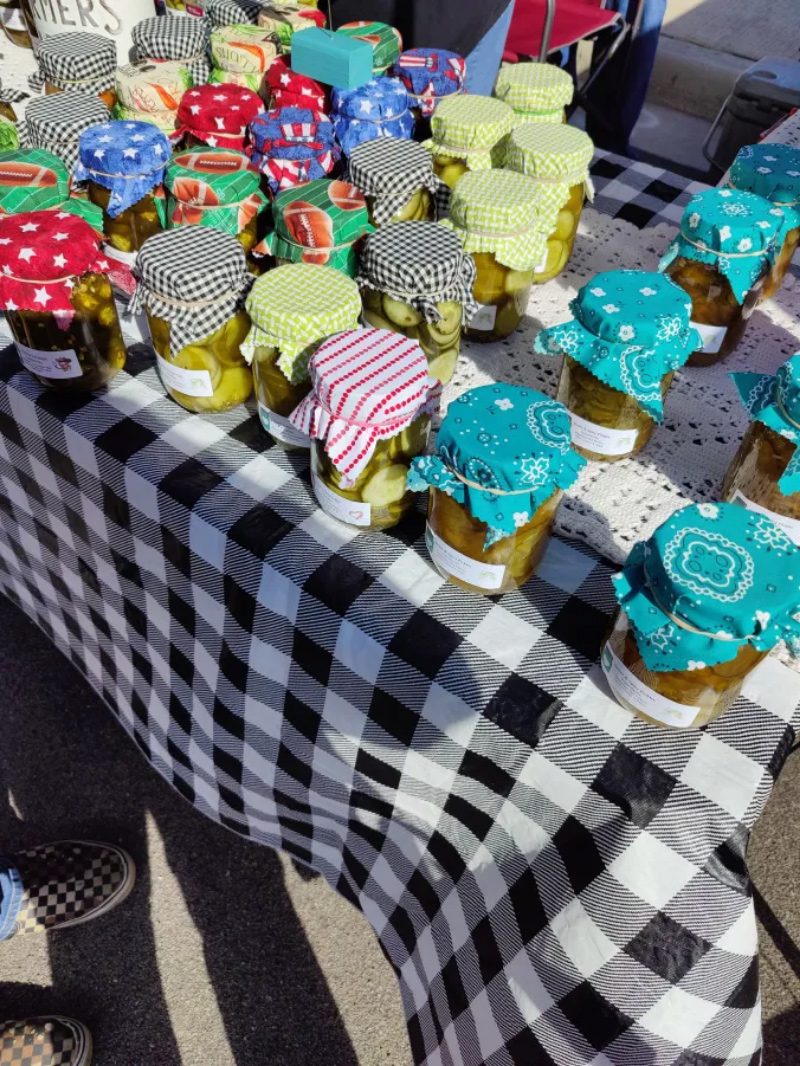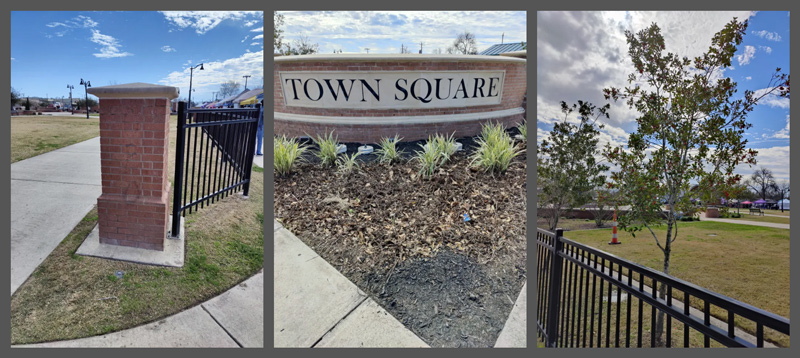Friday afternoon, I stood out in the backyard with the dogs as the wind whipped my hair around my face and threatened to topple the bench swing. I thought for sure the weather was going to thwart my plans of exploration yet again.
Thankfully, I was wrong. The Baytown Farmers Market was not cancelled or shut down early due to wind, rain, sleet, or any other strange weather Texas can throw our way. And so I was finally able to circle back to Exploration #12: 50 Things from How to Be an Explorer of the World by Keri Smith.

Exploration #12: 50 Things
I don’t know why I was so drawn to this particular exploration. It could simply be that, when I tried to do it before, I wasn’t able. I’ll admit that I’m a pretty stubborn person, so the simple fact that I couldn’t do it when I wanted made me want to do it even more. I also can’t say exactly why I was so determined to complete this exploration at the Baytown Farmers Market, especially considering the directions say to “Write down (or document) fifty things about one of the following: a trip to the library, a trip to the grocery store, a walk in your neighborhood.” I could easily have completed any of those three, but I thought a once-monthly pop-up farmers market would yield more interesting and diverse results.
 Lesson #1: Location matters.
Lesson #1: Location matters.
Regardless of my personal reasons, the third Saturday of the month did bring vendors with their tents and goods to the Baytown Town Square, and armed with Google Keep on my cell phone and twenty bucks in my wallet, I set out on my latest exploration.
I actually initially brought along my Rocket Notebook, a notepad that I can scan to my computer and then erase like a whiteboard, but I quickly realized that trying to write notes while walking around would be rather difficult and would distract me from my task. However, being a tech-savvy millennial, I can certainly type on a smart phone as I walk, so I switched to Google Keep.
Lesson #2: Find a way to collect data that is easy and won’t distract from the data itself.
One drawback I’ve found to the Google Keep app is that it doesn’t have an automatic list feature. I used to use a generic notes app that came on my phone and did have that ability, but I prefer being able to sync my notes with my Google Account. (Correction: Apparently Google Keep will actually do automatic numbering, but ya know, user error.) In the end, not having the automatic numbering may have been helpful anyway. I focused more on what I was seeing rather than how many I had or how many more I needed. I just wrote down everything that I saw, and I ended up with more than 50 things in total, even before counting variations of the same item.
Lesson #3: Focus on the quality of the data, not the quantity.
 Looking at my original list, I notice that I started with the obvious items that one would expect to find at a farmers market. The first items I wrote down were what I saw on the table where my husband and I first stopped to sample and purchase some homemade pickles and candied jalapenos. The mason jars completely covered the table and each had a cute piece of fabric wrapped around the lid. The jars will filled with every kind of vegetable that can be pickled, plus jams, salsas, and chowchow. When the vendor offered us a sample, he used tiny plastic tasting cups with tiny plastic spoons. Our purchases went into the green reusable shopping bag that my husband brought with us.
Looking at my original list, I notice that I started with the obvious items that one would expect to find at a farmers market. The first items I wrote down were what I saw on the table where my husband and I first stopped to sample and purchase some homemade pickles and candied jalapenos. The mason jars completely covered the table and each had a cute piece of fabric wrapped around the lid. The jars will filled with every kind of vegetable that can be pickled, plus jams, salsas, and chowchow. When the vendor offered us a sample, he used tiny plastic tasting cups with tiny plastic spoons. Our purchases went into the green reusable shopping bag that my husband brought with us.
From there, we continued walking down the tent-lined street as I frantically typed everything that I saw around me. I teetered back and forth between vague terms like “Baked goods” and “Plants” and specific details like “Pickles in clear plastic packaging” and “Tortilla chips in a brown paper bag.” Some items started generic but were followed by a list of the specifics, such as “Vegetables – turnips, beets, broccoli, cauliflower, Brussels sprouts, potatoes, greens,” while others stayed generic, such as “Bread mixes.”
Lesson #4: Figure out how specific or vague the data needs to be before embarking on collection.
Eventually, I started to stray from describing the vendors and looked at the area where the farmers market takes place. The vendors line a blocked-off street behind the Town Square park and stage. I noticed the faded yellow lines and rubber streaks in the street, then the steel and brick that make up the fence around the park. I’ve walked and driven around the Town Square many times before, so I didn’t see anything new, but I did look more closely at what I saw. My husband used an app on his phone to identify several of the plants, including fountain grass, spider plants, and a holly tree (am I the only one that thought holly was a bush?).

Lesson #5: Look beyond the expected.
Now that the farmers market is over, and I’m back at my computer, I could do more with the data I collected. I could put the list of items into another Google Sheet and do some coding. Maybe all of the goods for sale could be one color, and items that exist when the farmers market is gone could be another color. I could split the list into thirds and see what type of items I wrote at the start, then in the middle, and then in the end.
On the other hand, I’ve been trying to work on my refusal skills when it comes to taking on projects beyond what I have the time or ability to commit, so for the sake of this activity, I think I’ve done enough analysis.
Lesson #6: Only do as much analysis as the project calls for.
This post marks the half-way point of my planned journey to becoming an explorer of the world, and I’ve been thinking a lot about how this can be applied to teaching. The most obvious way is that this would make for an excellent activity to do with students. I could see it fitting easily into an English class, which is what I taught for seven years. It would be a great exercise in making inferences or in writing, but I can also see it fitting into a science curriculum, especially considering the number of options that incorporate exploring nature. At least one of my explorations has taken a turn for the quantitative, so I can also see how certain explorations could be used as activities in a math class. While I haven’t talked about it on this blog as much since I left the K12 classroom, student engagement and student-centered lessons are still important to me. Giving students the choice and freedom to complete explorations from this book could be an excellent way to foster that active engagement.
Beyond looking at what students could learn from these explorations, I’ve been contemplating how these have affected who I am as a teacher. Every time I sit down to choose an exploration or set out to complete it, I find myself slowing down. Considering how much this book focuses on noticing the things that are around us every day, I’d say that’s certainly one of the goals. I constantly have so many different things happening, deadlines and side projects and meetings, that it seems the only time I really let my brain zero in on one thing is when I’m working on these explorations. I think that is the lesson that I need to carry into my teaching: whether it’s my classroom teaching on Wednesday nights or my professional development seminars or when I’m working one-on-one with my faculty, I need to commit that same attention to detail, that same distraction-free focus, in everything I do.

Lesson #5 from this exploration is one that continues to resonate with me. Look beyond the expected. In conducting research, it is easy to become blinded by what you expect to see, which can obviously be detrimental to the end result of that research. When I’m researching a topic, I find that it’s comfortable to click on results that are familiar or expected, but if I always read what’s familiar and expected, I’ll never have the chance to expand what I know.
Credo Reference is full of unexpected information that may surprise you. Start with a topic you know. With more than 11,000 topics, anyone can find one they know well. Scroll through the results, and don’t limit yourself to page one results. As you scroll, look beyond the expected. Look for the surprises and let them guide the way.
Learn more about Credo Reference for colleges and universities and public libraries, and take a FREE TRIAL today!
Originally published on Mrs. Hebert’s Classroom on February 22, 2022. You can also listen to the podcast here:
Like this article? Check out the previous blog articles in this series:
- Learning to Be an Explorer of the World
- Exploring the World in Words
- Exploring Pointillism in My Backyard
Also, check out the next blog articles in this series:
- Exploring Beyond My Comfort Zone
- The Sounds of Exploration
- Exploring the Past (Without Time Travel)
- Exploring a World of Magic
See also:


